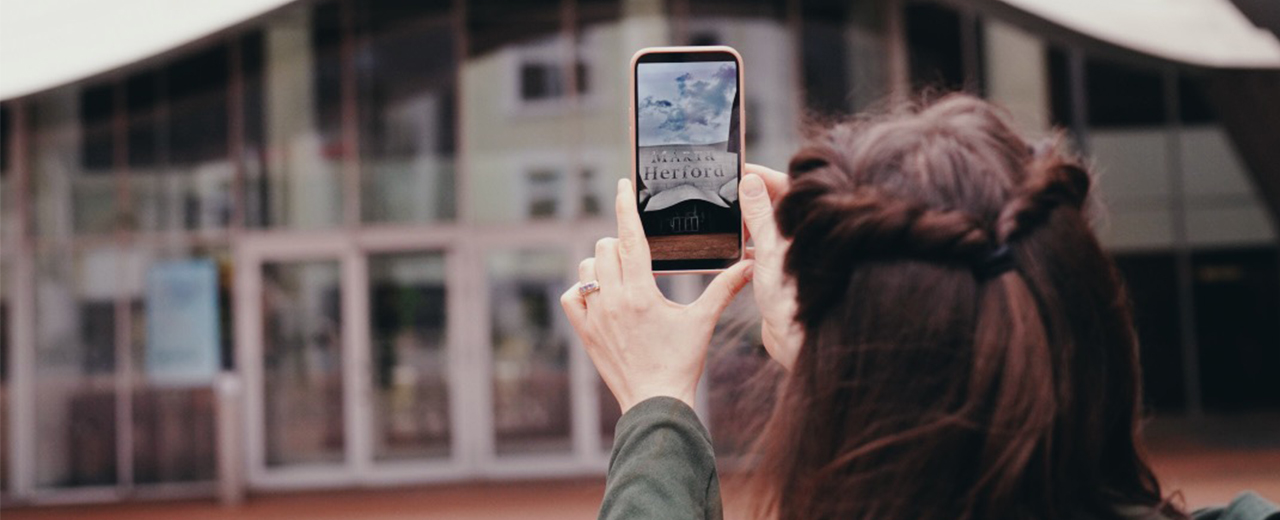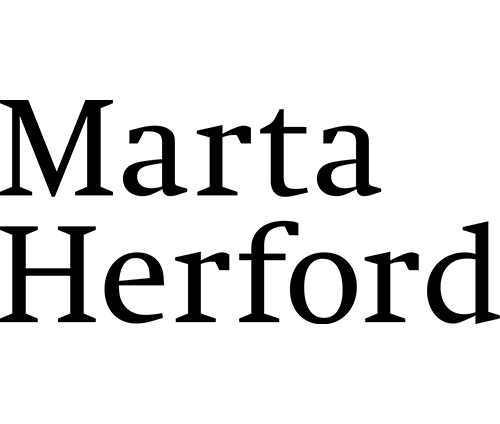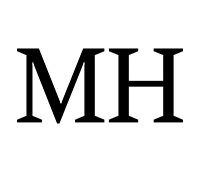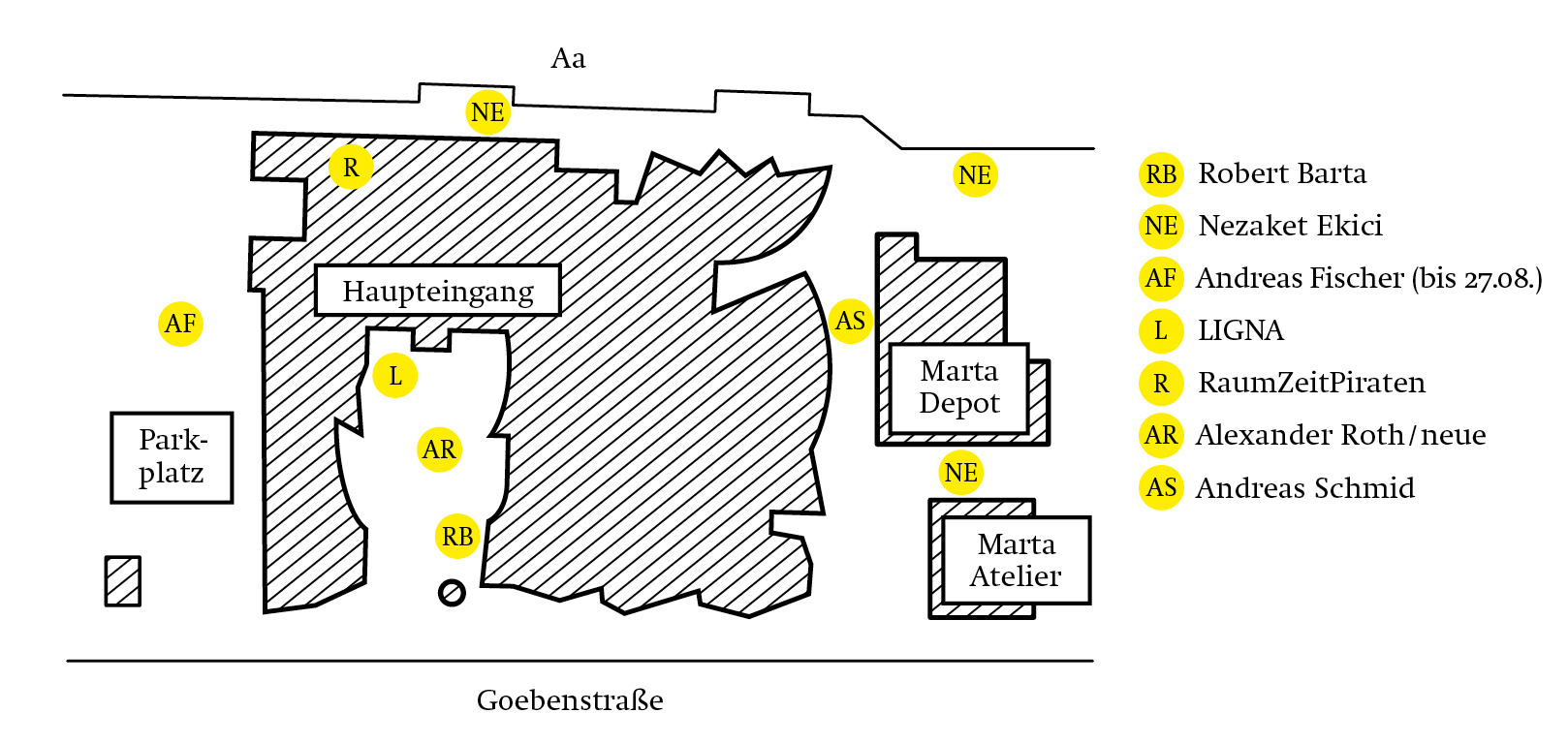
Marta Open Air
Art all around the Museum
Spring to autumn 2021
Under the heading of “Marta Open Air”, the museum work is extended outdoor. As of spring 2021 the grounds of the museum will be transformed into a living venue for art, inviting people to spend some time, discover and join in – socially distanced, outdoors and at any time. In their contributions, the artists engage with the perception of the space and the challenging Gehry architecture.
Even when the museum is closed, “Marta Open Air” is free of charge and accessible without restrictions. The program offers lots of scope for strolls, discoveries and the enjoyment of art. It includes sculptures, installations and participative exhibits, as well as a screen presentation that brings the art exhibited inside the museum outside to the visitors.
Up to autumn 2021 the tour around the museum is to be steadily extended, thus promoting a living dialogue between art, architecture, nature and the visitors. As an extension to the existing Audioguide (only available in German), which covers many of the works outside, the works are to be made not only experienceable in real life but also digitally accessible.
The audiowalk by LIGNA and the Pop-Up exhibition “Character Types” will start in mid-July.
Wolfgang Ellenrieder’s “Zapfen” in the “Public Street”, directly at the side entrance, offers an unexpected encounter. Even if you can’t enter the museum, you can see it through the glass on the car park – which almost makes you feel as if you were observing something hidden.
At “Marta Open Air”, however, it’s about expanding the limits of the museum space and rethinking the accessibility of works of art. This is also the central theme in Wolfgang Ellenrieder’s project “AMA / air mail art”. In this he created a series of works that can be packed in small parcels and sent without any great expense to institutions, galleries or private individuals where they can be blown up on site to unfold their actual size and weight.
What at first glance appears as if chiselled in stone turns out to be a taut plastic surface with pencil drawings printed on it. The Zapfen (or pine cone) was created while the artist was studying at the German Academy Villa Massimo in Rome, and alludes to the classical Italian motif that populates not only cultural sites but also the souvenir shops as a symbol of fertility.
A basketball hoop hangs on the curved façade of the museum building by Frank Gehry. At a height of exactly 305 centimetres, it corresponds to the standards for professional basketball, but there is something that irritates: the net of “Neverendingstory”, which extends down to the ground, is far too long, which robs the basket of its function as an item of sports equipment. If a ball were to land in the net, the game would immediately be over. With this absurd variation of an everyday article, the artist Robert Barta has created a metaphor for processes that simply won’t stop – not unlike the current coronavirus pandemic, which has also been a special challenge for artists. With a wink of the eye, however, his absurd article also calls on us to take a more relaxed view of things.
No monitoring! No fire hazard! On the car park beside the museum stands a trailer with a superstructure that looks like a mobile home. The window is closed by a shutter which occasionally moves. Sometimes there is a little light through the cracks, or we hear noises, but we never see what’s going on inside. Instead, the camera on the roof occasionally begins to smoke. The identical scene is repeated almost compulsively, and we have a vague feeling somewhere between uncertainty and a sense of absurdity. The strange constructions in the work by Andreas Fischer almost all bear signs of wear. For this purpose the artist uses scrapped appliances or found materials. By breathing new life into them, he is not only satirizing the consumer society, but also the heroic to totalitarian character of technology.
In three short videos that refer to actual places on the Marta grounds, the artist Nezaket Ekici invites people to become part of the performance. The clip “Crema” turns the arm into a whirling stirrer; in “Imagine”, the idea is to pick imaginary apples while dancing Flamenco. The video “Hullabelly” encourages people to swing their heads and their hips – almost like a belly dancer.
To get to the videos, simply scan in the QR code with your mobile phone, place it on the wooden holder and off you go: “Click & Perform”!
Andreas Schmid uses coloured adhesive tape and strings to trace the unusual architecture on the Marta grounds. He thus connects the curved brick façade of the museum and the adjacent utility building of the Marta Depot with the spatial surroundings. With his precise interventions the artist, sets up new visual axes and sharpens the perception of proportions. The obvious suddenly becomes incidental. Interstices are shifted into the focus, and details playfully examined. The harmonization of opposites and the deliberate limitation to a reduced language of form are essential starting points of his artistic approach.
Even in passing you become part of what is happening at the rear window façade of the museum building – by day and by night. At the start of the project, the visitors are standing in front of partially whitened panes of glass that, over the course of the project, are increasingly infused with drawings. The installation by the RaumZeitPiraten is revealed as an interrelated framework of sensors, cameras, robots, motion and projectors that interacts directly with the viewers: the active objects tug at their own cables, project and provoke their environment, and trace the path of their own movements on the glass. A constantly changing event of light and shade in the “DazwischenRaum”, the “in-between space” on the windows, which are the interface between inside and outside.
The RaumZeitPiraten are an artist collective consisting of Tobias Daemgen, Jan Ehlen and Moritz Ellerich. Their location-based multimedia installations engage with the relationship between man and machine, science and narrative.
The audiowalk by the artist collective LIGNA invites the participants to embark on a journey. The program “Ulysses 2.0” guides them along their own individual route without any fixed coordinates. The name comes from the novel “Ulysses” by James Joyce, an allusion to the travels and adventures of the Greek hero Odysseus. The subjective thought fragments and associations of the main character, Leopold Bloom, accompany the route taken. Peppered with insights of the biologist, Lynn Margulis, and the natural scientist, James Lovelock, it is about nothing less than the future of humanity, of the planet Earth and their relationship with each other. As its means the program uses the bodies of the listeners, their movements and the bacteria that accompany them and their environment. Everything seems to be connected. Are we not closer to nature than we think? Change direction, become conscious of the environment, encounter the other, transform yourself!
With the voices of: Josefine Israel, Samuel Weiß and Mareike Hein
Music: Günter Reznicek
The audiowalk is currently only available in the German language. Duration: ca. 70 minutes.
From the time we are children we are familiar with the use of alphabets. We usually tend to look at texts only in terms of content. We rarely look more closely at them to explore the language of form and the peculiarities of the letters used. In this pop-up exhibition the perspective is reversed: from reading to looking. It is a journey in time through 101 years of experimental font creation in the Netherlands with 12 alphabets by eight typographers: Peter Bil’ak, Wim Crouwel, Luc(as) de Groot, Erik van Blokland, Theo van Doesburg, Hansje van Halem, Just van Rossum and Gerard Unger. Unger also developed the “Swift” – an impressive example of which can be seen on the façade over the main entrance as the house font of the Museum Marta Herford.
Dank
Materialsponsor
Marta partners
Many thanks to the Marta Herford Corporate Partners and Corporate Premium Partners as well as the Marta Fund for New Art for their ongoing support of our program.





